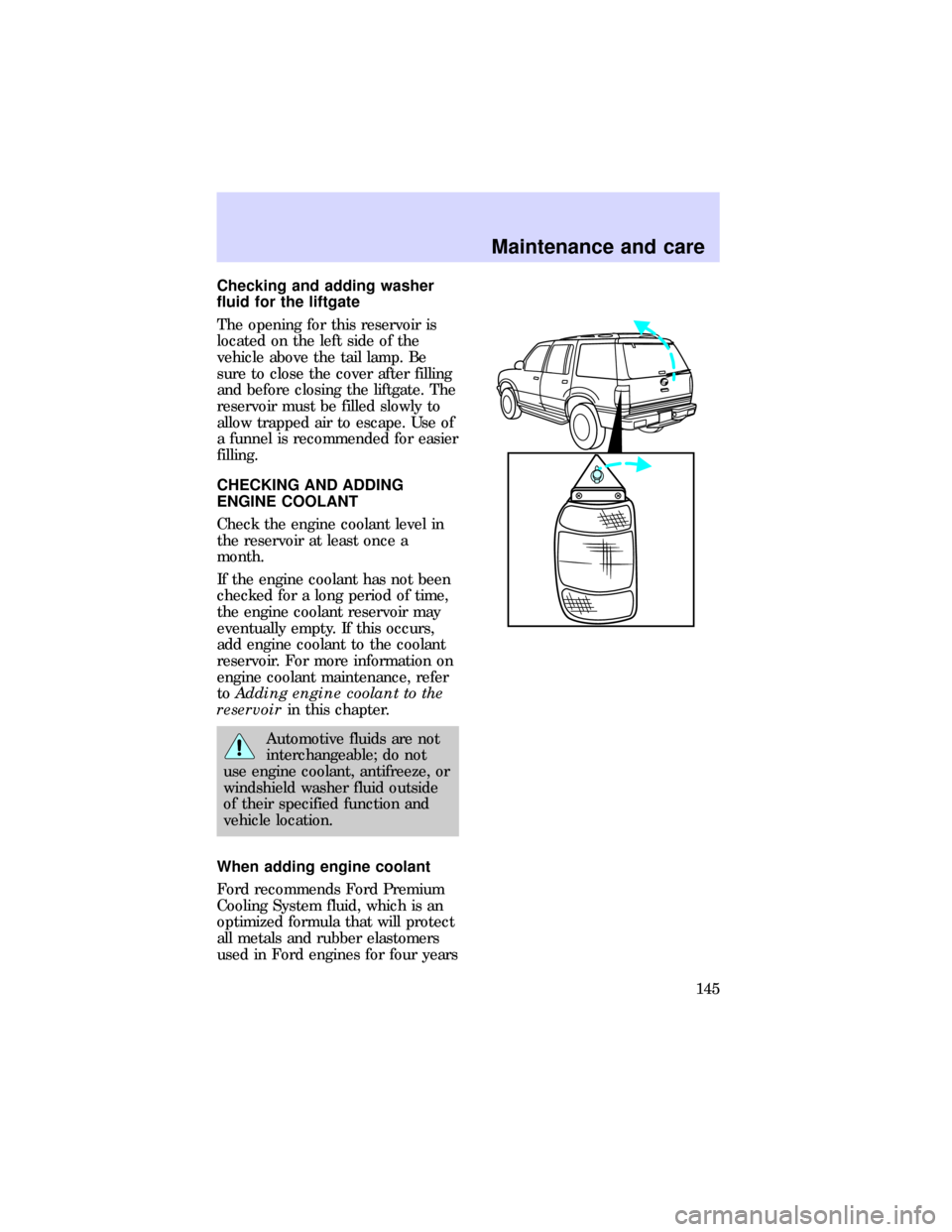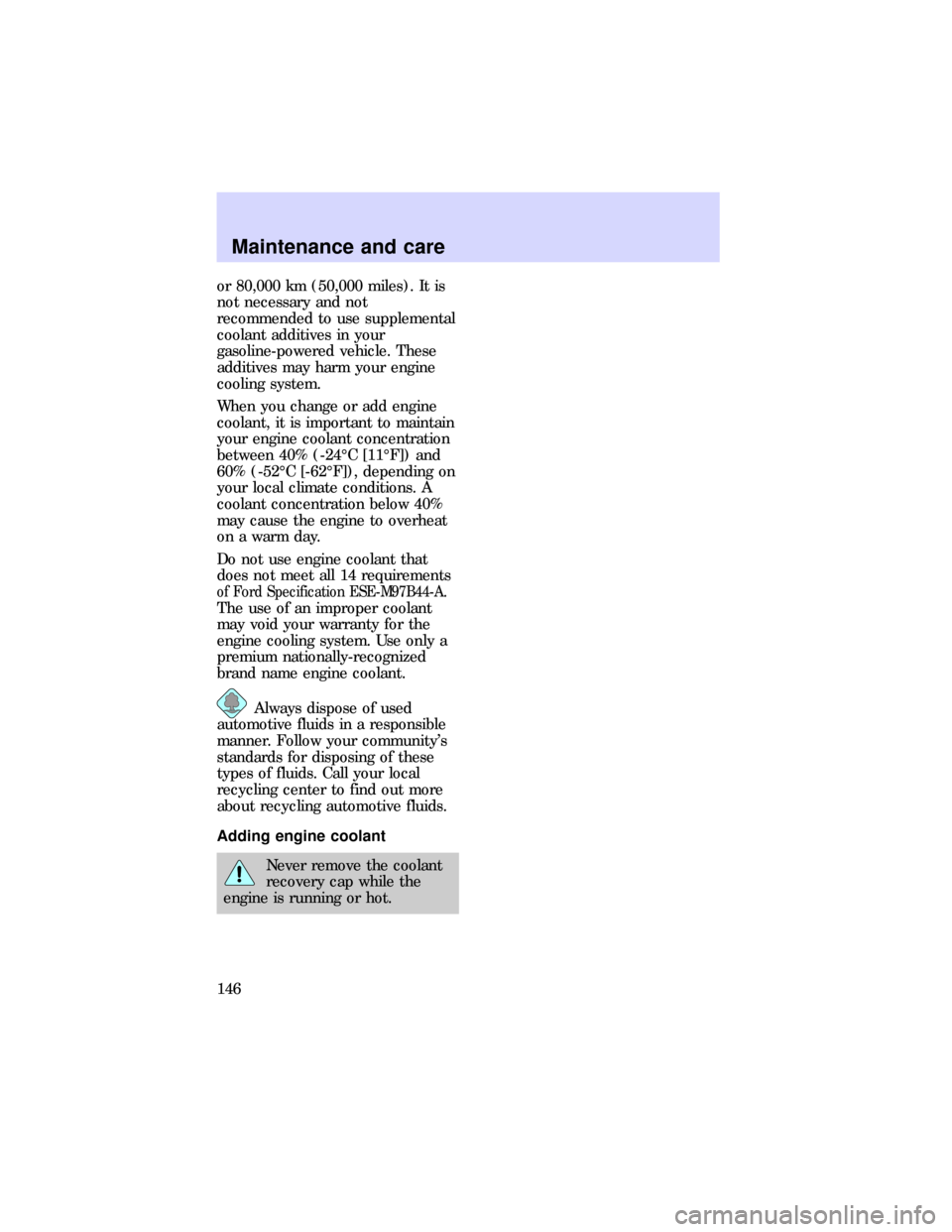cooling Mercury Mountaineer 1997 Owner's Manuals
[x] Cancel search | Manufacturer: MERCURY, Model Year: 1997, Model line: Mountaineer, Model: Mercury Mountaineer 1997Pages: 197, PDF Size: 2.08 MB
Page 21 of 197

Maximum heating
Set mode control to, turn
temperature control to maximum
heat (red) and set fan speed
control to maximum.
Maximum cooling
Set mode control to MAX A/C, turn
temperature control to maximum
cool (blue) and set fan speed
control to maximum.
Ventilating with outside air
Set mode control to, turn the
temperature control to the desired
temperature and turn fan speed
control to desired position.
Maximum windshield defrosting
Set mode control to, turn
temperature control to maximum
heat (red) and set fan speed
control to maximum speed.
²To prevent air intake restriction,
remove any snow, ice or leaves
from the air intake area located
directly under the windshield.
Controls and features
21
Page 114 of 197

Trailer lamps
Trailer lamps are required on most
towed vehicles. Make sure your
trailer lamps conform to Federal
and local regulations. See your
dealer or trailer rental agency for
the proper instructions and
equipment for hooking up trailer
lamps.
Do not hook the trailer
lamps directly into the
vehicle's lighting system wiring.
If the trailer lamps are not
installed properly, the warning
lights in the instrument cluster
may not work properly.
Driving while you tow
Do not drive faster than 88km/h
(55 mph) while towing a trailer. Do
not drive faster than 72 km/h (45
mph) while towing in hilly country
or on hot days.
Speed control may shut off if you
are towing on very long, steep
grades.
When towing a trailer:
²Use D (3rd gear) rather than
D(Overdrive) while towing up
or down steep hills. This will
eliminate excessive downshifting
and upshifting for optimum fuel
economy and transmission
cooling.
²Anticipate stops and brake
gradually.
Driving
114
Page 115 of 197

Servicing while towing
If you tow a trailer for long
distances, your vehicle will require
more frequent service intervals.
Refer to theService Guidefor
more information.
Trailer towing
²Practice turning, stopping and
backing in an area before
starting on a trip to get the feel
of the vehicle/trailer
combination. When turning,
drive slightly beyond the normal
turning point so the trailer
wheels will clear curbs and
other obstacles.
²Allow more room for stopping
with a trailer attached.
²The trailer tongue weight should
be 10-15% of the loaded trailer
weight for a Class I or II rear
bumper hitch.
²After you have travelled about
80 km (50 miles), thoroughly
check your hitch, electrical
connections and trailer wheel
lug nuts.
²When stopped in traffic for long
periods of time in hot weather,
place the gearshift in P (Park)
to increase idle speed. This aids
engine cooling and air
conditioner efficiency.
²Vehicles with trailers should not
be parked on a grade. If you
must park on a grade, place
wheel chocks under the trailer's
wheels.
Driving
115
Page 136 of 197

SERVICE RECOMMENDATIONS
Whenever possible, Ford has
designed parts that do not require
servicing. However, when servicing
is required, Ford's goal is to make
servicing your vehicle as easy as
possible. To help you:
²We highlight do-it-yourself items
in the engine compartment for
easy location.
²Often, parts (such as the
headlamp bulbs) may be
replaced without tools.
²We provide you with aService
Guidethat makes tracking
routine service of your vehicle
easy.
If your vehicle requires
professional servicing, your
dealership can provide the
necessary parts and service. Check
theWarranty Guideto find out
which parts and services are
covered. Use only recommended
fuels, lubricants, fluids, and service
parts conforming to Ford
specifications. Motorcraft parts are
designed and built to provide the
best performance in your vehicle.
Precautions for servicing your
vehicle
Be particularly careful when
inspecting or servicing your
vehicle. Here are some general
precautions for your safety:
²Do not work on a hot engine.
The engine cooling fan may
Maintenance and care
136
Page 137 of 197

come on unexpectedly; always
turn the engine off and let it
cool.
The cooling fan is
automatic and may come
on at any time. Always
disconnect the negative terminal
of the battery before working
near the fan.
²Never get under a vehicle
supported only by a jack. If you
must work under a vehicle, use
safety stands.
²Keep all lit cigarettes and other
smoking materials away from
the battery and all fuel-related
parts.
Working with the engine off
1. Set the parking brake and make
sure that the gearshift is securely
latched in P (Park).
2. Turn the engine off and remove
the key from the ignition.
3. Block the wheels to prevent the
vehicle from moving unexpectedly.
0020406080100
120
140
160
180
200P RND21
000000oooo
MPH km/h
UNLEADED
FUEL ONLY
RPM x 100012345
6H
C
F
E
RSM
SET
ACC
COAST OFF ON
SRS
- +H
H
L L
Maintenance and care
137
Page 145 of 197

Checking and adding washer
fluid for the liftgate
The opening for this reservoir is
located on the left side of the
vehicle above the tail lamp. Be
sure to close the cover after filling
and before closing the liftgate. The
reservoir must be filled slowly to
allow trapped air to escape. Use of
a funnel is recommended for easier
filling.
CHECKING AND ADDING
ENGINE COOLANT
Check the engine coolant level in
the reservoir at least once a
month.
If the engine coolant has not been
checked for a long period of time,
the engine coolant reservoir may
eventually empty. If this occurs,
add engine coolant to the coolant
reservoir. For more information on
engine coolant maintenance, refer
toAdding engine coolant to the
reservoirin this chapter.
Automotive fluids are not
interchangeable; do not
use engine coolant, antifreeze, or
windshield washer fluid outside
of their specified function and
vehicle location.
When adding engine coolant
Ford recommends Ford Premium
Cooling System fluid, which is an
optimized formula that will protect
all metals and rubber elastomers
used in Ford engines for four years
Maintenance and care
145
Page 146 of 197

or 80,000 km (50,000 miles). It is
not necessary and not
recommended to use supplemental
coolant additives in your
gasoline-powered vehicle. These
additives may harm your engine
cooling system.
When you change or add engine
coolant, it is important to maintain
your engine coolant concentration
between 40% (-24ÉC [11ÉF]) and
60% (-52ÉC [-62ÉF]), depending on
your local climate conditions. A
coolant concentration below 40%
may cause the engine to overheat
on a warm day.
Do not use engine coolant that
does not meet all 14 requirements
of Ford Specification ESE-M97B44-A.
The use of an improper coolant
may void your warranty for the
engine cooling system. Use only a
premium nationally-recognized
brand name engine coolant.
Always dispose of used
automotive fluids in a responsible
manner. Follow your community's
standards for disposing of these
types of fluids. Call your local
recycling center to find out more
about recycling automotive fluids.
Adding engine coolant
Never remove the coolant
recovery cap while the
engine is running or hot.
Maintenance and care
146
Page 148 of 197

Checking the cooling system
hoses
Before adding or replacing coolant,
inspect all cooling system hoses
for:
²deterioration
²leaks
²loose clamps
CHECKING AND ADDING
POWER STEERING FLUID
Check the power steering fluid at
least twice a year by completing
the following steps:
1. Start the engine.
2. When the engine coolant
temperature gauge reaches the
normal zone, turn off the engine.
CH
Maintenance and care
148
Page 189 of 197

ComponentFord part
nameFord part
numberFord
specification
Engine coolant Premium
Cooling System
FluidE2FX-19549-AA ESE-M97B44-A
Transfer case
front output
slip shaftPremium
Long-Life
GreaseXG-1-C or K ESA-M1C75-B
Transfer case Motorcraft
MERCONtAT FXT-2-QDX MERCONt
Dana 35 front
drive axle4x4 Gear Oil F1TZ-19580-A WSL-M2C191-A
1Add 118 ml (4oz.) of EST-M2C118-A Friction Modifier (part number
C8A2-19B546-A) for complete refill of Ford Traction-Lok rear axles.
ENGINE DATA
Engine5.0L (302 CID) OHV V-8
Displacement5.0L (302 CID)
Bore x Stroke10.16 x 7.62 cm (4.00 x 3.00 in.)
InductionPCM controlled sequential port fuel injection
IgnitionPCM controlled distributorless electronic
Firing order1-3-7-2-6-5-4-8
Spark plug gap1.3 - 1.4 mm (.052 - .056 in.)
Horsepower210 HP
Torque366.1 Nzm (270 lb/ft)
Compression ratio8.8:1
Capacities and specifications
189